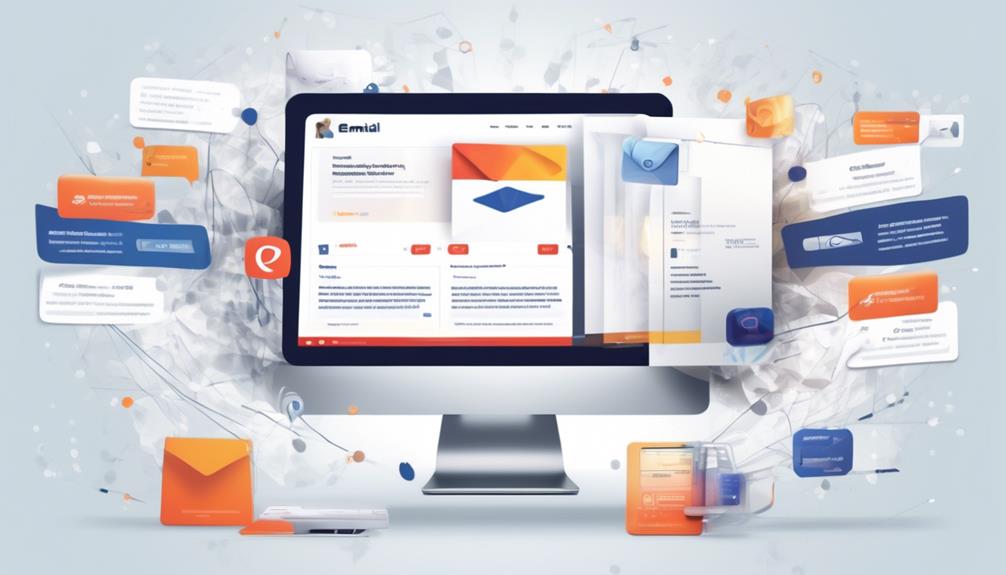In the journey through the digital world, email marketing serves as the guiding light, leading companies to their intended audience with accuracy and intention.
So, how does this intricate web of communication unfold in the realm of email marketing? Step by step, we unravel the intricacies of orchestrating impactful campaigns that resonate with subscribers and drive meaningful engagement.
From understanding the basics to crafting compelling content, each stage contributes to a seamless journey towards achieving marketing goals.
Join us as we dissect the process, revealing essential insights that can elevate your email marketing strategy to new heights.
Key Takeaways
- Email marketing allows businesses to send targeted messages to specific lists of customers and subscribers.
- Segmenting the email list based on various criteria helps businesses tailor their content and connect with their audience in a personalized way.
- The subject line plays a crucial role in grabbing the recipient’s attention and increasing open rates.
- Analyzing data and metrics helps businesses refine their email marketing strategies and improve engagement and conversion rates.
Understanding Email Marketing Basics
In email marketing, businesses send targeted marketing messages to specific lists of customers and subscribers, aiming to convert prospects into loyal brand advocates and achieve a significant return on investment.
The power of email marketing lies in its ability to help businesses connect with their audience in a personalized way. By segmenting the email list based on various criteria such as demographics, purchase history, or engagement level, businesses can tailor their content to resonate with different groups of people.
Crafting compelling email marketing messages involves more than just the body of the email; the subject line plays a crucial role in grabbing the recipient’s attention. A well-crafted subject line can entice the audience to open the email and engage with the content inside.
Additionally, creating an effective email marketing campaign requires a deep understanding of the audience’s preferences and behaviors. By analyzing data and metrics, businesses can refine their email marketing strategies to deliver relevant and valuable content that resonates with their subscribers, ultimately driving engagement and conversions.
Planning Your Email Strategy

To plan an effective email strategy, we need to carefully determine our target audience and define the messaging that will resonate with them. Understanding the preferences, behaviors, and needs of our target audience is crucial in creating successful email campaigns.
It’s essential to set clear goals and develop a content plan that aligns with our overall digital marketing strategy. This involves choosing the right types of email campaigns, such as welcome emails, promotional emails, or informational newsletters, that will best engage our audience.
Additionally, establishing a sending schedule and segmenting our email list based on demographics, behaviors, or engagement levels can significantly impact open rates and overall campaign effectiveness.
Selecting the appropriate email marketing service that suits our specific business needs is also vital. By adhering to best practices to help track and analyze email marketing campaigns, we can continuously improve our strategies and achieve better results.
It’s important to consistently refine our email marketing strategy based on the insights gained from the performance of previous marketing emails, ultimately leading to more effective and targeted campaigns.
Building Your Email List
After carefully planning our email strategy and identifying our target audience, the next crucial step is building our email list. To effectively grow your subscriber base, consider the following strategies:
- Utilize Various Channels: Incorporate website sign-up forms, social media, and events to organically attract email subscribers.
- Offer Incentives: Provide valuable lead magnets or incentives to encourage people to join your email list, such as exclusive content or promotional offers.
- Segment Your List: Use criteria like demographics or behavior to segment your email subscribers. This allows for the delivery of personalized and targeted emails, building trust and increasing engagement.
- Monitor and Analyze Performance: Regularly monitor the performance of your email marketing campaigns. Analyzing the data will help optimize and improve the results, ensuring the effectiveness of your efforts.
- Choose the Right Email Service Provider: Select an email service provider that aligns with your needs. Ensure it allows for personalized email capabilities and supports your list-building efforts.
Crafting Engaging Email Content

Crafting engaging email content involves captivating your audience’s attention from the very first line and maintaining their interest throughout the entire message. In the realm of email marketing, the subject line is the gateway to your content. It should be compelling, relevant, and entice recipients to open the email.
Once the email is opened, personalized and relevant content is essential. Tailoring the email to the interests and preferences of your target audience can significantly enhance engagement. Engaging visuals, such as images and GIFs, can make the email visually appealing and enhance readability.
Additionally, a clear and specific call to action (CTA) prompts recipients to take the desired action, further increasing engagement. Utilizing A/B testing can optimize email performance and ensure its effectiveness.
Furthermore, employing marketing automation to segment emails and send trigger emails based on specific actions or behaviors can also contribute to crafting engaging email content.
Measuring Email Marketing Results
Upon evaluating the success of our email marketing endeavors, we turn to measuring email marketing results to gauge the impact of our campaigns and refine our approach for enhanced engagement and conversion. To effectively measure our email marketing results, we focus on key metrics such as open rate, click-through rate, bounce rate, unsubscribes, and spam complaints.
Additionally, we compare our results with industry benchmarks to optimize our strategy for better engagement and conversion. Segmenting our email list allows us to target specific demographics and interests, enabling us to create more personalized and relevant content, ultimately improving engagement and response rates.
Frequently Asked Questions
What Are the 5 Steps of Email Marketing?
First, we choose the right email marketing service for our business needs and goals.
Then, we build an organic email list and segment it based on various criteria.
Next, we create a well-planned email campaign with focused content and a specific call to action.
Ensuring compliance with data privacy laws is crucial.
What Are the 10 Steps to Starting an Email Marketing?
We’ve discovered ten essential steps to kick-starting email marketing. It’s like laying the foundation for a sturdy house—each step builds upon the last, ensuring a solid structure.
First, we define our goals and target audience.
Then, we select a reliable email marketing platform.
Next, we craft compelling content and design eye-catching templates.
After that, we build our subscriber list.
Then, we test and optimize our campaigns.
What Are the 7 Email Marketing Strategies?
We implement seven email marketing strategies to maximize engagement and conversions.
- Personalization: By tailoring content to individual recipients, we create a more personalized and relevant email experience.
- Segmentation: We divide our email list into smaller, targeted segments based on demographics, interests, or behaviors. This allows us to send more targeted and tailored messages to each group.
- Automation: We automate our email workflows, sending timely and relevant messages based on triggers or specific actions taken by the recipients. This helps us deliver the right message at the right time.
- Optimizing for mobile: With a growing number of people checking their emails on mobile devices, we ensure that our emails are mobile-friendly and responsive. This enhances the user experience and increases the chances of engagement.
- Compelling subject lines: We craft attention-grabbing subject lines that entice recipients to open our emails. By using words that create curiosity or offer value, we increase the likelihood of our emails being opened.
- A/B testing: We conduct A/B tests to compare different versions of our emails and identify the most effective elements. This allows us to optimize our campaigns and improve engagement and conversions.
- Monitoring analytics: We regularly track and analyze email performance metrics such as open rates, click-through rates, and conversions. This data helps us understand what works and what doesn’t, enabling us to make data-driven decisions and continuously improve our email marketing campaigns.
What Are the 4 Types of Email Marketing?
Sure,
The four types of email marketing are:
- Newsletter emails: These emails are designed to share industry news and blog content with subscribers. They provide valuable information and insights to keep subscribers informed and engaged.
- Promotional email campaigns: These emails are focused on promoting products or services to subscribers. They often include special offers, discounts, or exclusive deals to encourage conversions and drive sales.
- Cart abandonment emails: These emails are sent to shoppers who have added items to their cart but have not completed their purchase. The goal is to remind and persuade them to come back and complete their transaction.
- Re-engagement campaigns: These emails target inactive subscribers who have not interacted with previous emails or engaged with the brand recently. The aim is to reignite their interest and encourage them to become active again.
Each type of email marketing serves a specific purpose in engaging and retaining subscribers.
Conclusion
In conclusion, email marketing is a valuable tool for businesses to engage with their audience and drive results.
Did you know that email marketing has an average return on investment of $42 for every $1 spent?
With the right strategy and execution, businesses can see significant success with email marketing campaigns.
So, if you’re looking to boost your marketing efforts, consider incorporating email marketing into your strategy for a high ROI.










